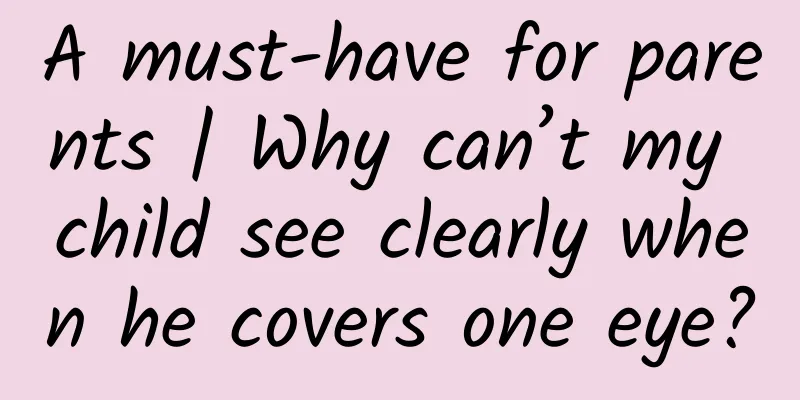A must-have for parents | Why can’t my child see clearly when he covers one eye?

|
"Our child can see clearly normally, how come he can't see clearly after covering one eye?" "Why is there such a big difference in the power of the child's two eyes?" "I originally thought that my child could see clearly and didn't need glasses, but the refractive examination results showed that he needed to wear glasses right away..." Parents often ask such questions, and these questions are most likely caused by the high degree of myopia in one eye. Many parents have only a vague understanding of the situation where the degree of myopia in their children's eyes is very different. So, today we will get to know a new term - anisometropia. Anisometropia Although we are binocular animals, in many cases the refractive power of our two eyes is not exactly the same. Myopia, hyperopia, and astigmatism can all be relative to a single eye. It is rare for the refractive power of both eyes to be absolutely equal in the population. There will be a certain amount of difference to a greater or lesser extent, and a slight difference is a very common phenomenon: for example, the right eye has 100 degrees of myopia and the left eye has 150 degrees of myopia. However, in most cases, the difference in refractive power of the two eyes will not be too large. When the difference in the spherical power of the two eyes is more than 150 degrees, or the difference in astigmatism is more than 100 degrees, it is called anisometropia. Anisometropia can manifest in many different forms. One eye may be emmetropic while the other is hyperopic, myopic, or astigmatic; or both eyes may have refractive errors but of different degrees or types. How does anisometropia occur? 1. Consider genetic factors Patients with high refractive error often have a family history of the condition. 2. Eye development Differences in the internal structures of the eyeball, such as choroid thickness, scleral toughness, corneal curvature and even intraocular pressure, may be involved. 3. Acquired Some acquired bad eye habits and lifestyle habits, such as writing with the head tilted for a long time, reading while lying on the side, watching TV or playing with mobile phones, etc., can cause or aggravate anisometropia. What harm does anisometropia cause? 1. Monocular vision When the refractive error exceeds a certain level, binocular single vision is destroyed. In the stage when visual development is not yet mature, in order to avoid the interference of blurred images, it will be inhibited involuntarily. The child does not have binocular single vision, but monocular single vision, that is, only the eye with better vision is used to see objects, and the other eye is abandoned. Monocular vision does not have normal depth vision and stereoscopic vision. 2. Amblyopia After the formation of monocular vision, the retina of the dominant eye is constantly stimulated by normal vision, and transmits visual information to the visual center through the visual pathway to form vision, and its visual function can be developed normally. The blurred image of the unused eye and the information it generates are suppressed, and the visual center does not respond to the visual information of the eye, which will form amblyopia over time. Many children with anisometropia tend to tilt their heads and look at things with slanted faces, and parents often mistakenly think that their children have strabismus. In fact, this is because the children's vision in both eyes is different, which causes them to prefer to use their good eye to see things. Long-term tilting of the head and slanting of the eyes will aggravate the degree of anisometropia, further increasing the degree of binocular vision, which in turn will aggravate incorrect reading and writing postures such as tilted head, thus entering a vicious circle. 3. Strabismus Amblyopia is not necessarily accompanied by strabismus, but if the visual function of this eye is suppressed and unused for a long time, strabismus is likely to occur. Parents, do your children have regular eye examinations? Suzhou Children's Vision Health Science Museum Children's Vision Health Science Popularization Base in China Focus on children's vision health and protect your eyesight with you |
>>: Why do people need to drink water? 9 benefits of drinking more water to detoxify
Recommend
What is the difference between Kangchun board and E0 grade board? What should I pay attention to when buying Kangchun board and E0 grade board?
Many friends are not familiar with Kangchun board...
What causes heavy blood clots during menstruation?
Menstruation is of great significance to female f...
Starting from the age of seven or eight, something gradually begins to accumulate in the blood vessels!
In January 2022, Nature Reviews Cardiology, a sub...
How painful is dysmenorrhea for girls
As we all know, every girl has her menstrual peri...
Why does a girl's vulva itch?
Nowadays, many women suffer from various gynecolo...
Will having a hysterectomy make you age faster?
I believe that every woman loves beauty very much...
What are the fun places in Sri Lanka? What special Sri Lankan food is worth recommending
Sri Lanka has high temperatures all year round, s...
Let you know about the hidden "fourth high" - hyperuricemia
As we all know, there are the famous "three ...
Why do I urinate more when my period is coming?
Menstruation is a very important physiological ph...
How to choose longli fish? Is longli fish an allergy-inducing food?
Longli fish is distributed along the coast of Chi...
What medicine should women take for insomnia and dreaminess
Everyone should have experienced insomnia and dre...
What should I do if I still have brown discharge after 9 days of menstruation?
Every woman has her menstrual period a few days a...
What are the dangers of women having leucorrhea?
Women's vaginas often secrete leucorrhea and ...
5 things you do during menstruation can easily cause gynecological diseases
Women have their periods every month. During thes...
Left ventricular strong spot gives birth to a boy
After pregnancy, the question of whether to have ...









